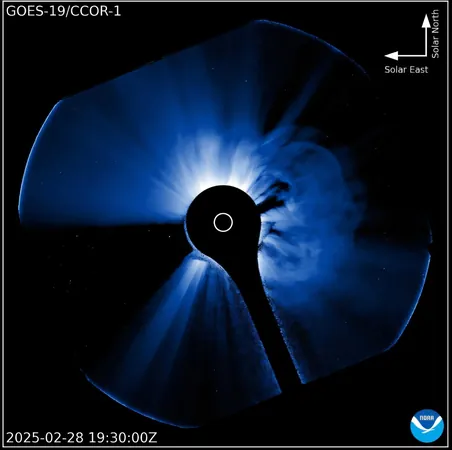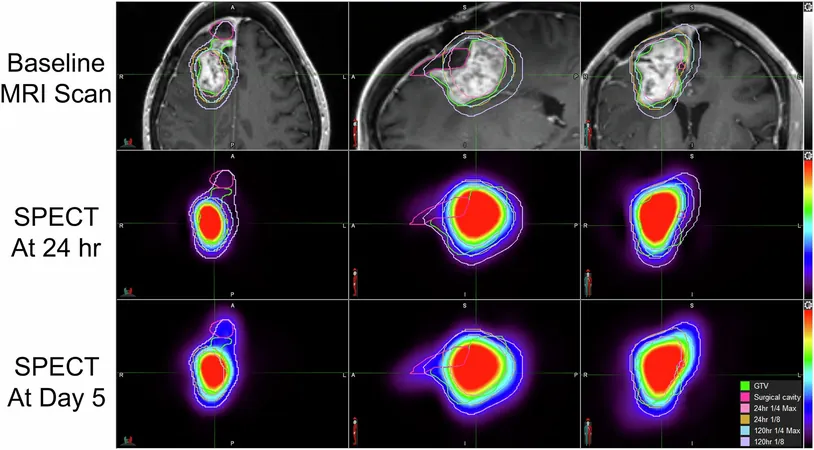
Unveiling the Future of Space Weather: NOAA's GOES-19 Satellite Releases Groundbreaking Data!
2025-03-28
Author: Rajesh
Introduction
In an exciting development for space weather enthusiasts and professionals alike, NOAA has made near real-time preliminary data available from its first Compact Coronagraph (CCOR-1) aboard the GOES-19 satellite. Launched in June 2024, GOES-19 began its significant data contributions on February 25, 2025, through the Space Weather Prediction Center (SWPC) website and will provide archived data from the National Centers for Environmental Information (NCEI) starting March 7, 2025.
What is CCOR-1?
CCOR-1 is revolutionizing the way we monitor solar activity by continuously observing the sun’s corona—the outermost layer of its atmosphere. This instrument is particularly adept at detecting coronal mass ejections (CMEs), which are large bursts of solar wind and magnetic fields rising above the solar corona or being released into space. These events can have profound effects on Earth, including disruptions to power grids, satellite functionality, radio communications, and GPS navigation systems.
Significance of CCOR-1
As the first state-of-the-art coronagraph designed specifically for space weather forecasting, CCOR-1 empowers the SWPC to predict geomagnetic storm conditions with unprecedented accuracy, enabling advanced warnings from one to three days ahead. This extended lead time can prove crucial in protecting national infrastructure, economic interests, and even national security. Power grid managers, aviation operators, and other industries that rely on accurate weather forecasting will benefit immensely from this innovation.
Data and Reporting
In an impressive upgrade, CCOR-1 provides data every 15 minutes. This rapid reporting is a stark contrast to its predecessor, the LASCO coronagraph, which often suffered from delays of hours. Since going operational in September 2024, CCOR-1 has already captured a plethora of space weather phenomena and stunning images, including numerous CMEs responsible for the powerful geomagnetic storm that struck on October 10, 2024, and various comets, including the striking Tsuchinshan-ATLAS (C/2023 A3).
Visual Appeal
But that's not all! The CCOR-1 instrument offers captivating visuals for astronomy fans. Twice daily, Earth 'photobombs' the CCOR-1’s field of view, resulting in beautiful flashes of 'earthshine,' a reflection of sunlight bouncing off our ocean and cloud cover. The moon also makes an appearance roughly once a day, shining brightly thanks to this same illumination.
Accessing the Data
For those eager to catch up on the latest solar activity, CCOR-1’s videos, including 24-hour snapshots of the sun’s behavior, are readily available on the SWPC website.
Official Operational Role
As a pivotal advancement in NOAA's monitoring efforts, GOES-19 will officially take on the operational role of GOES East on April 4, 2025. However, SWPC has already started using CCOR-1 data to enhance its space weather forecasting prowess.
Looking Ahead
Looking to the future, another nearly identical coronagraph, CCOR-2, is set to launch aboard NOAA’s Space Weather Follow On—Lagrange 1 (SWFO-L1) mission. This mission will place CCOR-2 closer to the sun at the L1 point—approximately one million miles from Earth—creating a backup for ongoing observations of the corona. Together, these two instruments promise unparalleled resilience and reliability in solar monitoring.
Conclusion
With this groundbreaking initiative, NOAA is not just stepping up its game in space weather forecasting—it's setting new standards for safety and preparedness in the face of our sun’s unpredictable behavior! Stay tuned for more incredible updates and make sure you're ready for any solar surprises that lie ahead!



 Brasil (PT)
Brasil (PT)
 Canada (EN)
Canada (EN)
 Chile (ES)
Chile (ES)
 Česko (CS)
Česko (CS)
 대한민국 (KO)
대한민국 (KO)
 España (ES)
España (ES)
 France (FR)
France (FR)
 Hong Kong (EN)
Hong Kong (EN)
 Italia (IT)
Italia (IT)
 日本 (JA)
日本 (JA)
 Magyarország (HU)
Magyarország (HU)
 Norge (NO)
Norge (NO)
 Polska (PL)
Polska (PL)
 Schweiz (DE)
Schweiz (DE)
 Singapore (EN)
Singapore (EN)
 Sverige (SV)
Sverige (SV)
 Suomi (FI)
Suomi (FI)
 Türkiye (TR)
Türkiye (TR)
 الإمارات العربية المتحدة (AR)
الإمارات العربية المتحدة (AR)